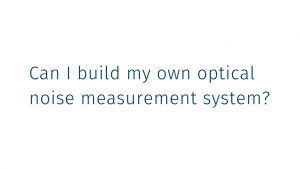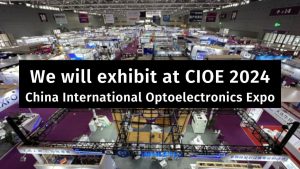Do you know how to measure Light Intensity Noise (RIN: Relative Intensity Noise)?
Light Intensity Noise is a noise that is caused by fluctuations in laser power, and its accurate measurement requires a high level of knowledge and skill. Therefore, it requires the use of a dedicated light intensity noise measurement system (analyzer/measuring instrument).
This article explains the applications and merits of light intensity noise measuring instruments, as well as points to consider when selecting a product. In addition, the features of one of the SYCATUS products, the A0010A RIN measurement system, will be introduced.
This should give you a better understanding of the structure and advantages of a light intensity noise meters. Now, let's get down to the topic at hand.
Features of the Light Intensity Noise Meter
A light intensity noise meter is a device that measures noise resulting from laser power fluctuations. Understanding its use is essential to obtaining more accurate measurement results.
The numerical results detected through the meter are an important indicator for quantitatively evaluating the performance and stability of the laser. In particular, lasers for telecommunications applications must have low relative intensity noise.
The advantage of light intensity noise meters is their high measurement accuracy and the fact that measurement results can be obtained in real time. This makes it possible to immediately identify problems and take corrective measures.
How to Use Light Intensity Noise Meter
Next, let's take a closer look at how to use the light intensity noise meter.
(1) Start up the light intensity noise meter and perform a warm-up.
If the warm-up is insufficient, measurement accuracy cannot be ensured, so at least one hour should be spent after startup.
(2) Set the measurement conditions of the light intensity noise meter.
Set the frequency range, number of measurement points, average number, etc. according to the purpose of the laser to be measured. For random noise measurements, averaging multiple measurement results enables analysis of noise characteristics.
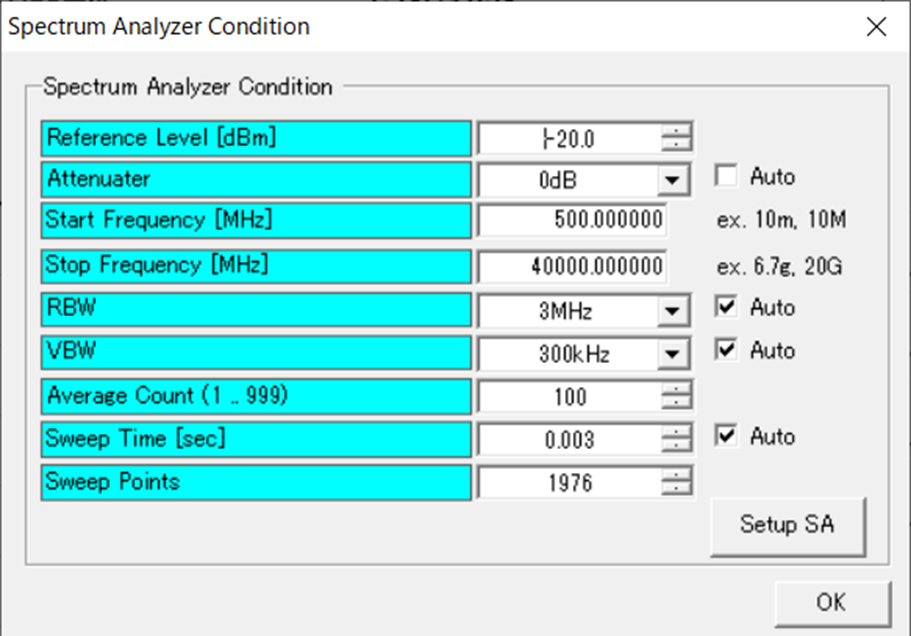
(3) Perform thermal noise calibration of the light intensity noise meter.
In order to correctly remove thermal noise from the light intensity noise meter, calibration is always performed when the temperature of the system equipment changes due to warm-up, etc., or when the measurement conditions change, such as frequency range.
(4) Adjust the light power of the laser to be measured using an optical attenuator.
To ensure the SN ratio of the measurement, adjust the optical power to as high a value as possible within the range not exceeding the maximum value allowed for the light intensity noise measurement device.
If the laser drive conditions are changed to adjust the optical power, the relative intensity noise will change, so the optical attenuator must be used.
(5) Input the laser light to be measured into the light intensity noise meter.
For safety, use the shutter of the optical attenuator to prevent leakage of laser light when connecting.
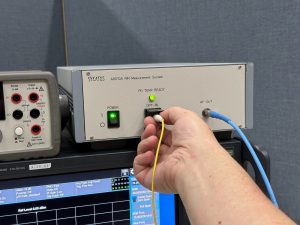
*The connection method varies depending on the type of meter and the laser to be measured, so please refer to the instruction manual of each product.
(6) After the connection is completed, release the shutter of the optical attenuator and start measurement.
(7) When measurement is completed, the measurement result is displayed on the light intensity noise meter.
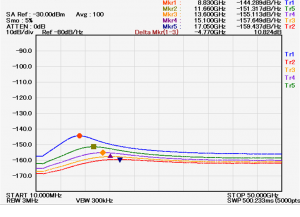
By following these steps to make measurements and analyzing the numerical results, it is possible to measure the quality of the laser.
These are the basic usage and features of the light intensity noise meter.
In the next section, we will take a closer look at points to consider when selecting a product.
Key Points in Selecting a Product
Commercially available light intensity noise meters can be used to make high-precision measurements immediately. In addition, some companies offer support and maintenance, so that in the unlikely event of a malfunction or defect, you can feel confident in requesting repairs.
Below are some points to consider when selecting a light intensity noise meter.
- Sensitivity: The sensitivity of a light intensity noise meter indicates its ability to detect low-level noise. Selecting a light intensity noise meter with high sensitivity will enable you to capture even the smallest noise.
- Frequency range: Check whether the instrument covers the frequency range of the intensity noise you wish to measure. Ideally, a meter that covers a wide range from low to high frequencies is ideal.
- Measurement accuracy: It is important to check whether the same value is obtained when repeated measurements are performed. Selecting a light intensity noise meter with high repeatability will help you obtain reliable data.
- Ease of use: Operability and data visibility are also important factors. An intuitive interface and easy-to-read display help smooth analysis.
When selecting a light intensity noise meter, the above points should be considered and balanced with the overall system requirements.
Next, we will introduce the light intensity noise meter made by SYCATUS (*), which has been trusted by many companies.
*What is SYCATUS?
SYCATUS Corporation is a company that develops products using cutting-edge optical technology in a wide range of fields such as optical communications, lasers, and sensors. Among our products, our optical noise measuring instruments are highly evaluated and adopted by research institutes and companies throughout Japan.
Features and Advantages of SYCATUS Light Intensity Noise Analyzers

The SYCATUS A0010A RIN Measurement System, a light intensity noise analyzer, has an established reputation for its accuracy and ease of use.
This light intensity noise analyzer is capable of measuring over a wide frequency range and comes with data analysis software. The software enables detailed data analysis and displays results in easy-to-understand graphs and tables. This makes it possible to instantly understand the noise intensity and characteristics of the laser.
Here are three features of the SYCATUS light intensity noise analyzer.
Feature 1: Supports a wide range of bandwidths
The SYCATUS light intensity noise analyzer can measure optical intensity noise over a wide frequency range of up to 50 GHz. Therefore, the noise characteristics of various lasers can be analyzed in detail.
Feature 2: Easy to operate
The SYCATUS light intensity noise analyzer is also easy to operate. The touch panel allows intuitive operation to set measurement conditions.
In addition, measurement results are immediately displayed on a graph, allowing data analysis and confirmation on the spot. This allows efficient analysis of light intensity noise.
Feature 3: Highly Accurate Detection and Reliable Japanese Manufacturing
The greatest advantage of the SYCATUS light intensity noise analyzer is their high accuracy and reliability.
Products are manufactured in Japan under strict quality control.
Sophisticated proprietary techniques are used to precisely calibrate the entire optical intensity noise analyzer to ensure measurement accuracy.
The SYCATUS light intensity noise analyzer provides stable performance over a long period of time. In addition, they provide highly reliable data as global standard instruments with extremely small instrumental differences.
These are the features and advantages of the A0010A RIN Measurement System, the light intensity noise analyzer from SYCATUS.
SYCATUS products meet all requirements for measurement accuracy, functionality, and software usability. We hope that this measuring instrument, which utilizes advanced optical technology, will become your reliable partner in the development, manufacturing, and evaluation of lasers.
Conclusion
In this article, we discussed the use and advantages of light intensity noise meters, as well as the key points for selecting a measuring instrument and the features and advantages of SYCATUS' measuring instruments.
When selecting a light intensity noise meter, it is important to consider various factors such as measurement range, accuracy, and operability, and to choose a product suitable for individual purposes and environments. Understanding the characteristics of the product and its optimal settings and usage will help you obtain more accurate measurement results.
Light intensity noise meters will continue to be a tool for a wide range of applications in the field of optical communications and light measurement.
Moreover, in this age of IT and AI, our lives and society will be further improved by technological advances.
Feel free to contact us.
As a pioneer in measurement in the field of optical communications and optical sensing, SYCATUS has been providing integrated hardware and software systems for measurement for over 20 years.
We will continue to provide innovative light measurement technologies developed on the basis of expertise, uniqueness, and accuracy to the world.
We also provide expert advice on a wide range of light measurement questions and concerns regarding the installation of system equipment.
Our experts are available to help you solve your light measurement problems.

